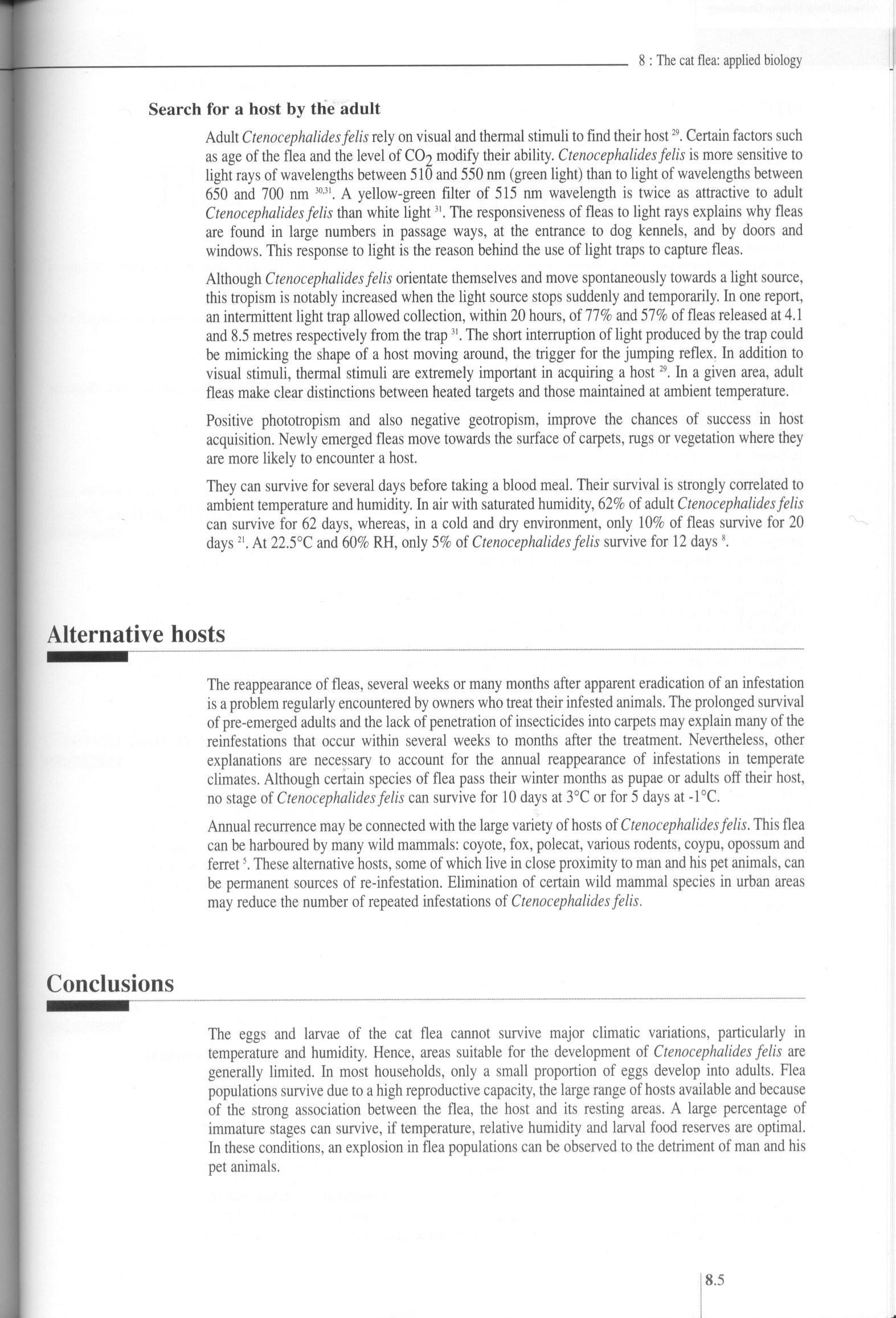85 (113)

8 : The cat flea: applied biology
Search for a host by the adult
Adult Ctenocephalidesfelis rely on visual and thermal stimuli to fmd their host29. Certain factors such as age of the flea and the level of CO2 modify their ability. Ctenocephalidesfelis is morę sensitive to light rays of wavelengths between 510 and 550 nm (green light) than to light of wavelengths between 650 and 700 nm 30’31. A yellow-green filter of 515 nm wavelength is twice as attractive to adult Ctenocephalidesfelis than white light31. The responsiveness of fleas to light rays explains why fleas are found in large numbers in passage ways, at the entrance to dog kennels, and by doors and Windows. This response to light is the reason behind the use of light traps to capture fleas.
Although Ctenocephalidesfelis orientate themselves and move spontaneously towards a light source, this tropism is notably increased when the light source stops suddenly and temporarily. In one report, an intermittent light trap allowed collection, within 20 hours, of 77% and 57% of fleas released at 4.1 and 8.5 metres respectively from the trap31. The short interruption of light produced by the trap could be mimicking the shape of a host moving around, the trigger for the jumping reflex. In addition to visual stimuli, thermal stimuli are extremely important in acąuiring a host29. In a given area, adult fleas make elear distinctions between heated targets and those maintained at ambient temperaturę.
Positive phototropism and also negative geotropism, improve the chances of success in host acąuisition. Newly emerged fleas move towards the surface of carpets, rugs or vegetation where they are morę likely to encounter a host.
They can survive for several days before taking a blood meal. Their survival is strongly correlated to ambient temperaturę and humidity. In air with saturated humidity, 62% of adult Ctenocephalides felis can survive for 62 days, whereas, in a cold and dry environment, only 10% of fleas survive for 20 days21. At 22.5°C and 60% RH, only 5% of Ctenocephalides felis survive for 12 days8.
Alternatiye hosts
The reappearance of fleas, several weeks or many months after apparent eradication of an infestation is a problem regularly encountered by owners who treat their infested animals. The prolonged survival of pre-emerged adults and the lack of penetration of insecticides into carpets may explain many of the reinfestations that occur within several weeks to months after the treatment. Nevertheless, other explanations are necessary to account for the annual reappearance of infestations in temperate climates. Although certain species of flea pass their winter months as pupae or adults off their host, no stage of Ctenocephalides felis can survive for 10 days at 3°C or for 5 days at -1°C.
Annual recurrence may be connected with the large variety of hosts of Ctenocephalides felis. This flea can be harboured by many wild mammals: coyote, fox, polecat, various rodents, coypu, opossum and ferret5. These altemative hosts, some of which live in close proximity to man and his pet animals, can be permanent sources of re-infestation. Elimination of certain wild mammal species in urban areas may reduce the number of repeated infestations of Ctenocephalides felis.
Conclusions
The eggs and larvae of the cat flea cannot survive major climatic variations, particularly in temperaturę and humidity. Hence, areas suitable for the development of Ctenocephalides felis are generally limited. In most households, only a smali proportion of eggs develop into adults. Flea populations survive due to a high reproductive capacity, the large rangę of hosts available and because of the strong association between the flea, the host and its resting areas. A large percentage of immature stages can survive, if temperaturę, relative humidity and larval food reserves are optimal. In these conditions, an explosion in flea populations can be observed to the detriment of man and his pet animals.
8.5
Wyszukiwarka
Podobne podstrony:
83 (123) 8 : The cat flea: applied biology Figurę8:3: Severalfemale Ctenocephalides felis feeding on
81 (122) M. W. DrydenThe cat flea: applied biology Cats and their environment are freąuently infeste
Technological quality of the product is highly dependent on characteristics and State of technologic
2 5 The negotiator in the soft style ; - Is soft on people and problem, - &n
Ask Me Everythingp Blasts from the pastPlants of the Mesozoic New greenery appeared on land and in t
f2 48 Search lndex Query
Download Biología, 1 (Libros de Texto) (Spanish Edition) PDF eBooks Free Are you also sea
Biologia e comportamento. PDF eBooks Download Are you also searching for PRINCIPAIS PRAGAS - Biologi
skanuj0067(1) •- ■ • . • :• ^ ^ Read the photo story in Students Book on pages 84-85. Close the book
THE STRUCTURE OF CLUSTERSFROM POTATO AMYLOPECTIN 113 When considering the extensive number of irwest
H 60 UH-60Q The Armys search for a better equipped, longer rangę and morę survivable MEDEYAC helico
screenh (31) © Phoxel Tourist Aid (By: Yaman Roumani) V Search for a country and display the languag
więcej podobnych podstron